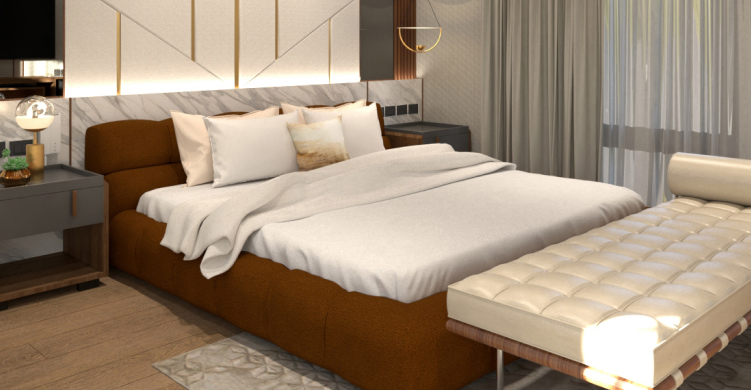11 Most Popular Design Styles in Manila
Interior design aims to create aesthetically pleasing and functional spaces, whether at home or in the office. Interior design styles are plentiful, with each one showcasing its own unique character and vibe. Knowing this, picking out one style may be a challenge for some, but with professional advice and assistance from a skilled and experienced interior designer in the Philippines, finding the interior design that matches your individual style and budget is quick and stress-free.
If you’re unsure which style you prefer for your home or office, it helps to know the most popular types of interior design styles in the Philippines, especially in Metro Manila – the country’s largest commercial and residential hub. Here are some of them:
Modern
Modern style can be defined as simple but sleek. It is focused on cleanliness and marked by the use of smooth lines, simple color palettes, and uncluttered spaces. To make up for the lack of fussy decorations and use of neutral colors, modern Filipino interior design styles make use of glass, metal or steel structures, furniture, and furnishings.
Modern designs for homes and offices call for a harmonious blend of simplicity and elegance. Maintaining a monochromatic scheme can help create a clean and polished look. Choose neutral hues as your base color; then, build on from that by adding complementing accent colors to add character to the design. If you want to add a touch of Filipino culture to your design, choose neutral, warm tones to match locally-produced furniture and furnishings, which are commonly made of hardwood, bamboo, and rattan.
When it comes to choosing decors and accents, choose functional pieces. This way, you can utilize elements that are both useful and provide a balanced and contemporary aesthetic. Select décor with a focus on sleek pieces that emphasize clean lines and open spaces.
Minimalist
Minimalism highlights the perfect blend of simplicity and functionality. Minimalist interior designers bring out effortless beauty rather than employing flamboyant accessories or decorations. It is usually marked by neutral and airy color palettes, the absence of clutter, and minimal use of essential furniture and natural objects.
The key to achieving a minimalist look is to reduce clutter to make the space look bigger. If you have limited space, you can create an illusory effect by using light colors, so your room looks more spacious. Neutral, monochromatic colors, coupled with bright and ample lighting can help achieve a clean and airy vibe.
While minimalist interiors have limited furnishings, you can still elevate them with elements made of various materials, like pottery, glass, timber, or cloth. Doing so adds dimension to the overall design. In addition, you can also add a stunning centerpiece to add visual interest to the room.
Shabby Chic
Feminine, soft, and delicate are the words that commonly describe a shabby chic interior. It focuses on delivering a vintage yet elegant vibe through the use of antique paint finishes and worn-out furniture. It mostly uses white and pastel colors, fabrics on sofas, and cotton-made curtains.
To achieve a delicate and romantic vibe, it’s best to use light and soft hues. Some designers use a white base or other neutral light colors for the walls. They might also add touches of pastel colors through the furnishings, like rugs, pillows, and other vintage accessories.
These should add to the theme’s softness and feminine vibe. Add white linens, floral prints, and other natural elements, such as plants or fresh flowers, to add flair and coziness to the overall design. You can also explore furnishings with curved and dramatic lines to elevate the look. Chandeliers, candlesticks, and other vintage, distressed furniture can also help achieve a timeless and romantic vibe.
Contemporary
Contemporary is different from modern. Contemporary evolves depending on the time period, based on the ideas of the here and now. Modern design, on the other hand, is confined to the style that started in the 20th century. Contemporary displays a trendy fashion with less adherence to any style.
Since contemporary design trends are ever-evolving, the base hue for contemporary-style interiors is often neutral, like white, gray, and black. These colors allow you to update your style easily as they can blend well with other colors, no matter what’s on trend. You can liven up the space by adding pops of bold colors to your furnishings, such as rugs, pillows, or lighting fixtures.
Contemporary designs embrace the minimalist philosophy. Hence, it’s important to leave negative spaces where possible and avoid prints. If you want decorations, opt for items with geometric shapes and clean lines. Art pieces and other contemporary decor can also help elevate the design. Add spotlights or use track lighting to draw the eyes to your accent elements.
Transitional
A mix of traditional and modern design makes up a transitional style. Its use of neutral colors, refined furnishings, and simple lines creates a sense of balance and sophisticated space that looks both appealing and inviting.
If you’re trying to achieve a transitional interior design, choose traditional neutrals as your base color palette, and pair it with natural colors, like blue and green. You can use whites and sandy hues, or opt for dark, bold neutrals for a more masculine vibe. Add some pops of color with vibrant pillows, curtains, or furniture.
Transitional interiors incorporate a harmonious blend of masculine and feminine vibes. Add metallic elements with stylish light fixtures or tables and chairs. You can soften this with cushions and pillows. You may also choose sofas in bold colors or play with patterns and textures to liven up and add dimension to the space.
Classic or Traditional Filipino
If you love antiques, classic arts, and objects with history, then go traditional. It is a timeless style that travels back from the past to bring out future designs. Dark wood tones, classic details, and rich color palettes, all with significant numbers of lines and curves are at the focal point of traditional spaces.
With the Philippines being a tropical country, you can add warm, neutral tones to your color palette. These colors can blend well with natural elements, like wood and plants, which are abundant in the country. You can also add vibrant, earthy colors, such as rust and burnt orange, in different areas to add vitality to the overall color scheme.
If you want to incorporate Filipino aesthetics, make use of traditional weaving and textiles for a unique Pinoy touch. You can also add ornaments and pieces of furniture made of indigenous materials, like abaca, rattan, and capiz shells. Lastly, you can add antique pieces, like family heirlooms, as the focal point of your decoration. Nostalgic pieces give a sense of warmth and belonging, which is reflective of a tight-knit Filipino family.
Rustic
Experience a warm and homey interior house design in the Philippines with rustic style. This theme is predominated by raw wood, stone, comfortable furnishings, and other natural materials.
Neutral tones are usually applied as the base color in this style, so the attention is drawn toward the raw items. For your overall color palette, stick to earthy hues, like cream, brown, and green, to match the natural and organic elements that are commonly added to this design style.
Rustic interiors have a lot of wooden elements. You can find a lot of furniture and ornaments made of wood and natural materials, such as narra, mahogany, rattan, or bamboo. Add a wooden shelf to display family photographs and potted plants or flowers.
Industrial
Industrial design features warehouse looks with high ceilings, open spaces, hanging metal fixtures, exposed concrete, and unfinished brickwork. It is similar to the modern style but with lofty raw furnishings. It uses both new and recycled materials.
With its raw and unfinished look, designers would recommend using neutral colors, such as gray and darker tones. Elevate this color palette with wooden elements, metal, and bricks to subtly break the monochrome.
Embrace the edginess and rawness of this design style with ornaments made of wood and steel materials. Abstract art pieces can also serve as interesting visuals. Complete the look with raw lighting fixtures, like metal pendants or bare light bulbs.
Eclectic
The eclectic design embraces freedom and individuality. This style offers fewer boundaries where you can freely express your personality, and borrow ideas from other styles, such as modern and bohemian. It is frequently incorporated with mix-and-match textures that translate into a unique personality.
Eclectic interiors feature a variety of colors, patterns, and textures. To achieve a cohesive look, follow a specific color scheme to guide the elements you’re going to add. You may consider painting your walls with neutral colors so they can contrast well with vibrant furniture and ornaments.
You can play around random prints and patterns for the decor. Some designers may recommend mixing and matching elements and design styles from different eras. You can also have a gallery wall and hang your favorite photographs or art pieces. Just be sure to maintain a harmonious blend between colors, patterns, and textures so as not to overwhelm the eyes.
Bohemian
The Bohemian style is targeted toward free-spirited and laid-back people; but nowadays, it is among the most popular styles suitable to anyone who likes a simple, relaxing abode. A Bohemian room is equipped with a mix of old and new furniture, coupled with intricate patterns, prints, and rich tones, thereby creating a cheerful atmosphere that speaks of an outgoing personality.
Bohemian or boho-inspired interiors make use of natural colors, like brown, gray, and green. These colors are often accented with jewel tones, like ruby red or emerald green, or bold colors, such as turquoise, purple, or orange, to add playfulness and vibrancy to the overall look and feel of the space.
Bohemian designs embrace the layering of textures and patterns. Adorn the walls with macrame and wooden ornaments. For your carpets and pillowcases, choose pieces with printed and patterned designs. You can also add vintage and eclectic elements. Indoor plants can also complement this design style well.
Asian/Zen
Asian homes are synonymous with tranquility and serenity as they often provide a quiet and peaceful ambiance. A touch of nature is often depicted in zen interiors by using pebbles, stones, plants, and other natural elements to create a simple yet scenic and relaxing landscape. An interior designer in Manila can accomplish Zen’s harmony and balance by utilizing natural colors, well-defined lines, and symmetry.
Asian Zen interiors aim to provide calmness and relaxation. So, its color palette usually features soft, natural hues, like beige, white, and gray. These colors are often complemented with other natural hues, like blue, green, orange, and yellow.
When decorating a Zen-inspired office or home, go for simple and minimal pieces. You can also explore furniture made of wood and rattan. Blend some textures from natural fabrics, like wool and cotton to add softness and coziness to the atmosphere. Don’t forget to add a touch of nature with plants and pebbles.
Small House
Small houses have risen in popularity in recent years. As space is at a premium, tiny houses feature a light and airy vibe to create an illusion of a bigger room. Pieces of furniture are often used to serve multiple purposes to keep the elements at a minimum. In addition, small houses often utilize vertical spaces to maximize the space and make room for other furniture and accents.
The key to making a space look bigger is using light colors. While whites and creams are commonly used, you can also explore other light hues of green or blue to liven up the space. Monochromatic color schemes can also make it more open and balanced.
Small spaces can easily look cluttered if you add in a lot of elements, so keep in mind to stay minimal. Add mirrors to create an illusion of space. Chairs, tables, and other pieces of furniture with slim legs can also make rooms appear spacious. Aside from that, you can maximize the vertical space with hanging shelves, plants, and other ornaments to elevate the design while minimizing the use of floor space.
Key Takeaways
People often spend most of their time at home or at the office. Hence, it’s important that the interior design is carefully thought out to maximize functionality, to provide comfort, and to provide aesthetically pleasing spaces.
When picking out an interior design for condos, homes, and offices, choose a style that reflects your personality and supports your needs. For spaces for coffee interior or office, consider functionality alongside aesthetics. This way, you can ensure that your chosen design doesn’t only look good but is also functional, and can maximize your quality of life as well.
If you want to give your home or office a fresh new look, interior designers can help you find the right layout and style that matches your needs and wants. Rock Robins Design Studio Co is experienced in creating contemporary and modern styles for residential and commercial projects. Contact us today and let’s put your vision to life.






